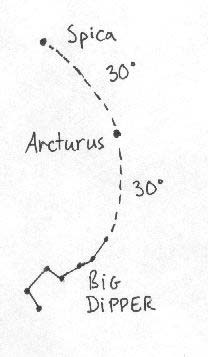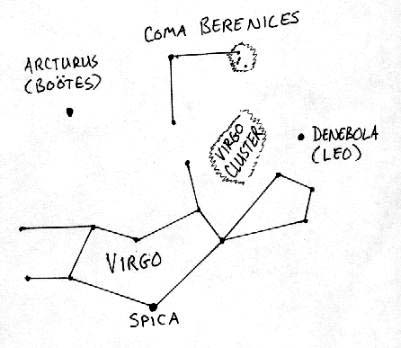Virgo, the Virgin, follows Leo along the ecliptic, and is visible in the southwest at dusk. There are a number of myths about who this virgin represents, many of them suggesting fertility or harvest. Indeed, when Virgo is in the sky, in the spring and summer, crops will grow, but they will not grow if she is not visible.
 Virgo's brightest star is Spica, which in many drawings of the constellation represents the virgin's ample backside. To find Spica, first follow the arc of the Big Dipper's handle to Arcturus, which is high overhead in the early evening. Then continue on in roughly the same direction for another 30 degrees (three fist-widths), and the brightest star in that region, a bit below the ecliptic, is Spica. This completes the mnemonic phrase: Follow the Arc to Arcturus, then Straight on to Spica.
Virgo's brightest star is Spica, which in many drawings of the constellation represents the virgin's ample backside. To find Spica, first follow the arc of the Big Dipper's handle to Arcturus, which is high overhead in the early evening. Then continue on in roughly the same direction for another 30 degrees (three fist-widths), and the brightest star in that region, a bit below the ecliptic, is Spica. This completes the mnemonic phrase: Follow the Arc to Arcturus, then Straight on to Spica.(By the way, if you had trouble seeing the dimmer stars of Bootes when Arcturus was in the west, try looking for them again while the constellation is overhead. You may be able to see them now, since you are looking through less atmosphere, less pollution, and less ground light.)

The other stars in Virgo are not notably bright, but most of the body should be visible from a dark location in a city. Her legs extend out to the left, her head is to the right, and an arm reaches out from the body. That arm cradles the Virgo Cluster of galaxies, and it points toward faint Coma Berenices (KOH-ma bear-uh-NICE-eez), the Hair of Berenice. When you look at this region of the sky, you are looking out perpendicular to our own galaxy's plane. With less interference from nearby stars and cosmic bric-a-brac, it is possible to see galaxies million of light years away. You will need a telescope, though, to see any of the thousands of galaxies in this area.
Our own galaxy, visible to us as the Milky Way, is part of a 40-ish-galaxy cluster called the Local Group. The Local Group, the Virgo and Coma clusters, and other groups combine to make the Virgo (or Local) Supercluster. Considering that the Virgo Cluster is some 55 million light years from Earth, "local" is a relative term. If our Milky Way galaxy were one foot wide, the Virgo Cluster would be 400 feet away.
Meanwhile, in truly local news: Jupiter is also dropping out of sight this month as Leo chases it toward the western horizon. Also this week, a new lunar cycle begins, with the new Moon on July 29.
If you have never followed the daily progression of the Moon's phases, consider making this your Moon Month. You do know that the word "month" is derived from moon, don't you? Of course you do.
The first week, or quarter, of the lunar month is occupied with the waxing (growing) crescent moon. Look at the Moon each night at dusk. The crescent will be round on the right, with the points to the left. Each day it will be a bit higher in the sky, and each day the crescent will be thicker, until next Sunday's first quarter Moon, when the right half is illuminated and the left half is dark. If you have binoculars, point them towards the Moon to see more detail. If you have an artistic nature, sketch the Moon's shape and position each night.
During the first few days of the first quarter, you can see the shadowy outline of the dark portion of the Moon. This phenomenon is called earthshine, and is caused by Sun's light reflecting off Earth's surface onto the Moon. It is also known as "the old moon in the new moon's arms."
All of these elements - waxing crescent Moon, earthshine, and Jupiter - come together on July 2. Look to the west at dusk to see the crescent Moon perched between low-slung Jupiter and Leo's sickle-shaped head. By the time the first quarter rolls around on Sunday, the Moon will have moved up the ecliptic to near Spica.

The Piker Press moderates all comments.
Click here for the commenting policy.